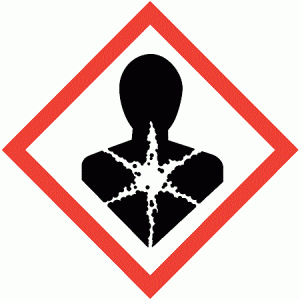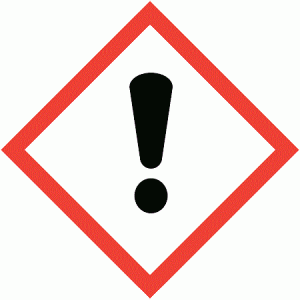UTK Environmental Health & Safety Guide LS-022
Exposure to isoflurane waste anesthetic gases has been associated with several health concerns and can occur when vapors escape into the work environment during the administration of anesthesia. This guide illustrates safe practices for isoflurane use.
Effective Date: 07/17/2020
Revision Date: 07/17/2020
Introduction
Isoflurane is a volatile halogenated anesthetic agent frequently used in animal research. It is a clear, colorless, nonflammable, volatile liquid at room temperature and pressure. It has an odor that has been described as ether-like or sweet. Exposure to isoflurane waste anesthetic gases has been associated with several health concerns and can occur when vapors escape into the work environment during the administration of anesthesia.

 Health Effects
Health Effects
Acute effects: Headaches, dizziness, lightheadedness, nausea, fatigue, irritability, depression.
Chronic effects: Liver and kidney disease.
Reproductive effects: Some halogenated anesthetics have been associated with birth defects or miscarriages.
Minimize Exposure
The National Institute for Occupational Safety and Health (NIOSH) Recommended Exposure Limit (REL) for isoflurane is 2 parts per million (ppm) in a one hour time period. Because the olfactory threshold is 50 ppm, using odor detection to qualitatively assess exposure potential may lead to overexposure. Contact Environmental Health & Safety (EHS) at safety@utk.edu or 965-974-5084 for assistance with exposure assessment.
Active Scavenging (Preferred): Whenever possible work in a chemical fume hood or hard-ducted Class II, Type B biological safety cabinet (BSC). Other ducted local exhaust ventilation systems such as a downdraft table or point ventilation (e.g. snorkel) may also be useful. Ductless fume hoods that rely on activated charcoal filters also help to minimize isoflurane exposure.
Passive Scavenging (Less Effective): When a fume hood or other local exhaust ventilation is not available charcoal canisters must be used to scavenge waste isoflurane vapors. These devices must be properly installed and maintained in order to be effective. Follow manufacturer instructions as printed on the label. Weigh the canister before and immediately after each use and replace when the weight reaches maximum capacity.
Anesthetic Equipment Maintenance: Anesthesia machines must be maintained annually or as directed by the manufacturer. Fittings, tubing and connection must be checked routinely with seals and damaged components replaced as necessary. A refrigerant leak detector or soap bubble test should be periodically used to check for gas leaks.
Considerations for Working with Isoflurane in Anesthesia Machines
- There are many types of anesthesia machines on campus. Ensure personnel have been trained to use the specific piece of equipment they will be using. Review and understand manufacturer’s instructions prior to use.
- Verify equipment is currently in working condition and certified.
- Fill vaporizer with isoflurane either in a fume hood (or ducted BSC) or using an anti-spill bottle adaptor. Use a certified local exhaust ventilation system, preferably a fume hood or ducted BSC, to remove waste anesthetic gas. Wear chemical resistant (e.g. nitrile) gloves, lab coat, and eye protection while filling.
- Avoid high concentrations (>5%) of isoflurane for induction or for prolonged periods. Turn off the vaporizer when not administering anesthetic to animals.
- Close the induction chamber lid during anesthetic gas delivery. If possible, use a sliding top chamber, purge the chamber with oxygen for 3-5 seconds before opening, and stand as far back as possible to keep waste anesthetic gas from entering your breathing zone.
- Use a coaxial nose cone. Select the best-fitting nose cone with a tight-fitting diaphragm to minimize leakage.
- Exhaust waste anesthetic gas to either a fume hood, ducted BSC, or properly weighed and maintained charcoal canister.
- When performing stereotaxic procedures, waste anesthetic gas can escape below the animal’s head. Use a downdraft table, perform the procedure in a ducted BSC, or obtain a device specially made for this procedure.
One-Drop or Bell Jar Method
This procedure should be reserved for instances when only a short duration of anesthesia is required (typically 30 seconds for mice or 60 seconds for rats). The procedure must take place in a fume hood, ducted BSC, or suitable ventilated enclosure. A gasketed chamber with an exhaust port to scavenge waste gas may also be used. If performing the procedure in the field, choose an area with good ventilation. Stay upwind whenever possible. If performed in an enclosed temporary field station, open at least two sides of the wall tent for air circulation.
First Aid Procedures
If inhaled, remove to fresh air. Call 911 for immediate medical attention. In case of skin or eye contact, immediately flush with water for 15 minutes. Use an eyewash for eye exposures. Follow up according to UT Office of Risk Management accident/injury protocols (see https://riskmanagement.tennessee.edu/).
Spills and Waste
Spills: Small volumes of isoflurane evaporate readily at normal room temperatures and may dissipate before any attempts to clean up or collect the liquid are initiated. If a small spill occurs, rapidly absorb any liquid with absorbent pads or paper towels and place in chemical fume hood for safe evaporation. For large spills of >50 mL (e.g. bottle knocked over or broken bottle), immediately evacuate the area and call EHS for assistance.
Waste: Contact EHS for disposal of unused, expired or unwanted isoflurane or stock solutions as hazardous waste. Alternatively, contact the Office of Laboratory Animal Care (865-974-5634) to return solutions to the College of Veterinary Medicine pharmacy. Spent charcoal canisters should be sealed in a plastic bag, properly labeled, and submitted to EHS as hazardous waste. Do not discard in the conventional trash.
For questions about this guidance, contact Environmental Health & Safety (865-974-5084 or safety@utk.edu).
Disclaimer
The information provided in these guidelines is designed for educational use only and is not a substitute for specific training or experience.
The University of Tennessee Knoxville and the authors of these guidelines assume no liability for any individual’s use of or reliance upon any material contained or referenced herein. The material contained in these guidelines may not be the most current.
This material may be freely distributed for nonprofit educational use. However, if included in publications, written or electronic, attributions must be made to the author. Commercial use of this material is prohibited without express written permission from the author.